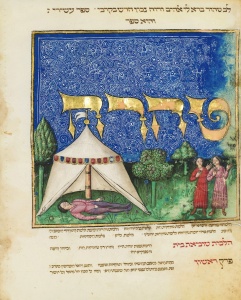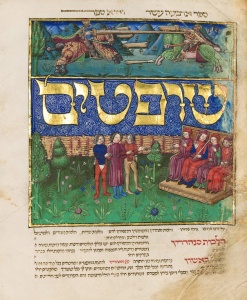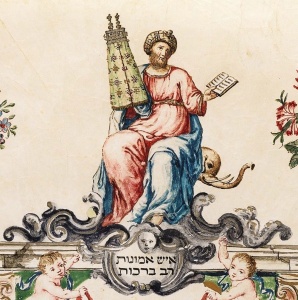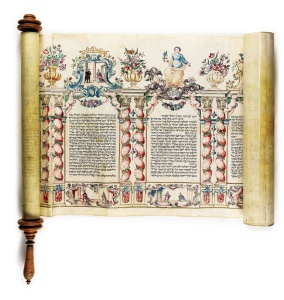Steinhardt’s Legacy
Michael and Judy Steinhardt are putting up their magnificent Judaica collection for sale at Sotheby’s in New York on April 29th. The results of 44 years of diverse collecting will be on view from Wednesday April 24 and simply must be seen by anyone interested in Jewish visual and material culture.
![North German Bronze Lion-Form Aquamanile (late 12th century, probably Magdeburg) Inscribed in Hebrew, "T[his is the] d[onation of] t[he] y[oung man], Berakhi[ah] Segal [the Levite]." Courtesy Sotheby’s North German Bronze Lion-Form Aquamanile (late 12th century, probably Magdeburg) Inscribed in Hebrew, "T[his is the] d[onation of] t[he] y[oung man], Berakhi[ah] Segal [the Levite]." Courtesy Sotheby’s](https://richardmcbee.com/wp-content/uploads/2013/04/Aquamanile-300x225.jpg)
The Steinhardts are of course well known for their many philanthropic endeavors, perhaps most notably the Taglit-Birthright Israel program, co-founded with Charles Bronfman, to enable every Jewish person between the ages of 18 and 26 to visit Israel. Their generosity and foresight has fostered a priceless connection of over 330,000 young adults with the Land of Israel and their Jewish heritage. Curiously, this role as a conduit between Jewish values and the larger assimilated world finds its reflection in some of their most notable items of Judaica.

Previewing the collection with Sotheby’s consultants David Wachtel and Sharon Liberman Mintz, they noted many items that absolutely demanded mention. One thing that was easily missed was the fact that this collection contained possibly the most important assemblage of Jewish textiles ever to come on the market. A rich Italian silk brocade Readers Desk Cover, lot 104, competes with a brocade Torah Binder, lot 105, both 18th century, for our attention. In fact, there is a panoply of over 30 Torah Binders; embroidered, painted and otherwise decorated and reflecting differing customs throughout 200 years of European traditions. Many diverse aspects of Jewish life are revealed in these objects; such as a pair of Alsatian Passover textiles (1832), lot 183. Reflecting Alsatian folk art, this richly decorated “show towel,” used to cover the hand-washing towels used during the seder, are inscribed with the names of the family, an image of Adam and Eve in the Garden, a medallion showing the family at the seder table as well as elaborate floral motifs.
Not unexpectedly, silver objects command a great deal of attention. The English silver Lord Mayor’s Dish (1719), lot 84, is notable as one of 7 surviving annual silver gifts given to the Mayor of London by the Bevis Marks Synagogue between 1697 and 1719. It represents the attempt to curry favor with the English authorities and gain acceptance of the Jewish community, only first allowed to return to England in 1655.
The early 18th century Venetian silver Torah crown accompanied by Torah finials, lot 77, is significant in that it has survived as a set. Its ornate baroque decorations animate the surface in a way that fully complements the sound of the bells suspended from the finials as they strike the inside of the crown, as they were designed to do whenever the Torah was taken from its aron.

Equally rare is a bronze Lion-Shaped Aquamanile from north Germany (12th century), lot 51. It is the earliest of 4 known surviving aquamanile (human and animal shaped water vessels for ritual hand washing) bearing Hebrew inscriptions. The fact that this archetypical medieval object was almost certainly used in synagogue for the Levitical washing of the Cohen’s hands is a startling example of cultural crossover from Christian art into Jewish ritual.
The two undisputed masterpieces in the Steinhardt Collection are the 15th century Frankfurt Mishneh Torah (estimate $4.5M to $6M) – and the monumental illuminated 18th century Italian Megillat Esther (estimate $600,000-$800,000). They both radically appropriate non-Jewish methodologies to champion deeply Jewish values. Each establishes a vital paradigm of how Jews can creatively operate within the larger world and at the same time proudly affirm core Jewish values.
The Frankfurt Mishneh Torah, dated to 1457 and sumptuously illuminated in northern Italy, is the second of two volumes, the first currently in the Vatican. Both volumes were written by the same scribe but illuminated by different artists. The artist of this volume has been identified by NYU Professor Jonathan J. G. Alexander as the “Master of the Barbo Missal,” known for his skill and refinement typical of the Ferrara school of manuscript illumination. This is the only Hebrew work he illuminated.
The exceptional quality of this Mishneh Torah cannot be emphasized enough. There are only three other illuminated copies of the Rambam text in existence and this one stands alone as presenting detailed illustrations of the actual halachic text. Six of the eight books (chapters) are graced with full-page frontispieces; gold-leaf initial word panels and illustrations of the pertinent subject at hand. Unlike almost all other illuminated manuscripts that are copies of earlier prototypes, the Frankfurt Mishneh Torah has absolutely no precedent. Each and every image was created specifically for this manuscript. Of equal importance is the fact that the non-Jewish artist had to be instructed by the scribe or rabbinic authority as to what each image should depict. This was an intense creative partnership unlike any other in manuscript illumination.
The Avodah panel depicts the golden domed Temple (an octagonal building reflecting the Jerusalem Dome of the Rock) with first one priest slaughtering on one side and then another burning the sacrifice. Korbanot is represented by preparations for the first Passover Seder: men assembled with their staffs in hand stand around a set Passover table while a boy prepares to roast a lamb on a spit. Issues of ritual purity are explored in Tohorot with a well-dressed lad lying dead in a tent and two figures heatedly discussing the complications of “tent contamination.” In one of the most vivid images, Nezikin, a violent knife fight unfolds alongside a thief breaking into a house through a window and stealing clothing. Above, an ass falls into an unguarded pit, making the pit’s owner liable for damages, whereas the alleged scene of the goring ox is curiously pacific. While the ox seems to be only nudging the fallen person it thus reflects the Rambam in Halacha 10 that butting is a derivative of goring and also subject to damages. The intricacies of Kinyan are explored whereas on the right a man acquires a horse by leading it into his domain, while on the left two individuals discussing the purchase of a house effect nothing until money or a deed is exchanged. In each one of these images the artist has gone well beyond superficial illustration by consistently opening up the complexities of Jewish law that the Rambam elucidates, sometimes showing its application and at others its exceptions.


Shofetim is an excellent case in point. The defendant is standing before the court, held by two armed guards. Curiously there are four seated judges presiding. While we all know that the minimum court is made up of three judges, a court of four seems puzzling until we read Halacha 5 and 6 together.
“5. When a city does not possess two sages of great knowledge – one fit to teach and issue rulings with regard to the entire Torah and one who knows how to listen diligently and knows how to raise questions and arrive at solutions – a court should NOT be appointed for it even though thousands of Jews live there.
6. When a court has two judges of this caliber; one capable of listening with regard to the entire Torah, and one capable of expounding, it is a valid court. If there are three, it is of intermediate esteem. If the court possess four judges who can expound upon the entire Torah, it is a wise court.” It would seem that the artist is illustrating the requisite quality of the judges necessary to establish a valid court, making us closely read the halacha through the eyes of the Rambam.
After the sumptuous complexities of the Frankfurt Mishneh Torah (only some of which we have examined), it is hard to imagine an illuminated manuscript as fascinating. And yet the Illuminated Megillat Esther, lot 100, from mid-18th century northern Italy truly rises to the task. Judged as perhaps “the most important Esther scroll to come to the market ever,” it is indeed monumental at 21 inches in height, 202 inches in length and elaborately adorned with twisting columns, garlands, ornate cartouches, flying putti and floral decorations. Along the bottom panels imaginative scenes from the text are illustrated as well as crowned cartouches atop every other column. All that notwithstanding, what sets this Megillat Esther apart is that it is one of only seven surviving megillot in existence exhibiting an extremely significant allegorical program. Ten allegorical figures based on Cesare Ripa’s Iconologia (1593) are featured above every other column. Iconologia was a highly influential “handbook of allegories, personifications and symbols of vices and virtues” used extensively by writers, artists and poets well into the 19th century. It essentially created a commonly understood symbolic language of the educated European elite. Its use in a Jewish ritual object, alongside pertinent Hebrew quotations that echoed its allegories, was a major step of integration with emerging Enlightenment culture.
The allegorical figure of Hope is seen gazing heavenward; her hands in prayer while an anchor (stability) rests behind her. This clearly echoes both Esther and Mordechai’s underlying emotion as the megillah unfolds. The Hebrew cartouche proclaims, “Trust in the Lord with all your heart” (Proverbs 3:5). The allegory of Faith utilizes a profoundly Jewish image of a man holding an Italian sefer Torah seated before an elephant with the Hebrew quote from Proverbs 28:20, “A faithful man will have many blessings.” It is found over the terrifying text in which Haman dictates the total destruction of the Jews in the letters sent to all the king’s provinces (Esther 12-14). Finally, the allegory of Mercy, a woman holding a cedar branch flanked by a pelican piercing its own breast to feed its chicks is above the Hebrew, “He caused them also to be pitied “(Psalms 106:46). This is directly above the passage in which King Ahasuerus gives Haman’s house to Esther, a clear act of mercy (Esther 8:1).
What is remarkable throughout this beautiful megillah is the seamless integration of European secular symbolism with biblical narrative and wisdom. Ripa’s allegories allowed the timeless tale of Esther to feel fully contemporary and relevant to the world of 18th century Italian Jews.
The exhibition of the Steinhardt Collection at Sotheby’s is a landmark event for many reasons, not the least of which is that it is a special opportunity to examine those pieces of Judaica that have over the centuries operated as a bridge between the larger European culture and Jewish ideas and values. In a curious way, much like Steinhardt’s Birthright Program, this exhibition explores the cultural heritage that is our birthright as compelling as the Land of Israel.
The Steinhardt Collection at Sotheby’s
Auction: Monday April 29, 2013: Session 1; 10am; Session 2; 2 pm
Exhibition: Wednesday April 24 – Sunday April 28; 10am – 5pm
1334 York Avenue at 72nd Street, New York
www.sothebys.com